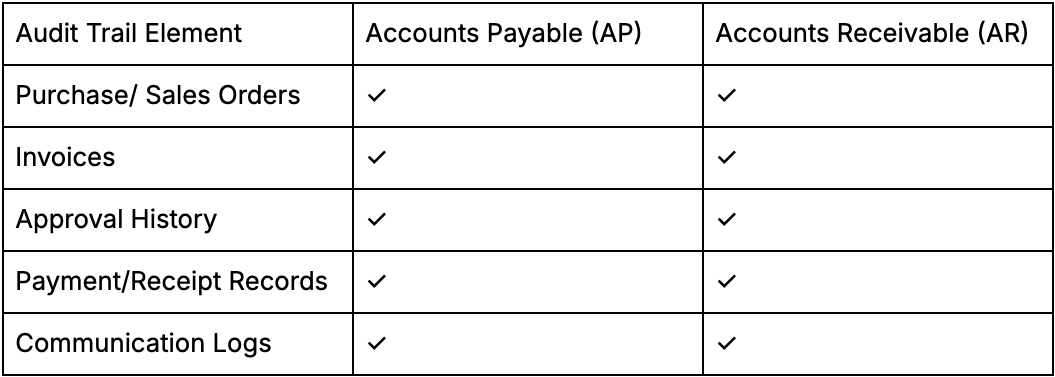
In today’s increasingly digitised financial landscape, transparency, traceability, and compliance are paramount. This is especially true in accounts payable (AP) and accounts receivable (AR) processes, where financial inaccuracies or missing documentation can lead to regulatory scrutiny, operational disruptions, and loss of trust. A robust audit trail not only mitigates these risks but also acts as a cornerstone for building secure, scalable, and automated financial systems.
In this article, we explore what an audit trail is, its critical role in AP and AR, and why it’s absolutely non-negotiable in your automation strategy.
A financial audit trail is a detailed, chronological record that documents every step, action, and change related to a financial transaction. This includes when and by whom a document or transaction was created, modified, reviewed, approved, or deleted.
In simple terms, if you’ve ever asked, “Who authorised this payment and when?”, that’s exactly what an audit trail is designed to answer.
Audit trails serve several essential purposes:
Without it, businesses are vulnerable to fraud, errors, and compliance failures, with no way to prove or trace what occurred.
Audit trails are used in:
They’re particularly valuable in AP and AR, where a single error can cascade across ledgers, teams, and systems.
Audit trails provide the necessary visibility, control, and documentation to ensure financial accuracy and meet regulatory standards in automated systems.
Having reliable data logs builds trust across finance teams and stakeholders. With audit trails, every transaction becomes verifiable.
Audits become easier and faster when documents and changes are fully traceable. This saves hours, if not days, during year-end or external reviews.
Audit trails enable early detection of fraud, system breaches, and errors.
By reviewing historical logs, companies can identify recurring bottlenecks and optimise workflows.
In AP and AR audits, a reliable audit trail enables you to:
With automation, audit trails become part of the system, not an afterthought.
To ensure completeness, your audit trail should include:
Typical AP audit trail includes:
Common AR documents tracked:

Use AP automation tools that log changes in real-time. Manual logging invites errors.
Consistent document formats and file naming help with traceability.
Use role-based access controls and track all login and edit attempts.
Ensure everyone understands how audit trails work and why they matter.
Run periodic audits to verify the completeness and accuracy of your logs.
What is an audit trail in finance?
An audit trail is a time-stamped log of every action taken on a transaction or document—who did what, when and how. In AP/AR it traces creation, edits, approvals and payments, so you can answer “who authorised this and when?” instantly.
Why is an audit trail essential in AP automation?
Because it gives verifiable transparency and control. A robust audit trail:
What should a good audit trail include, and how do I keep it compliant?
Include the essentials: precise timestamps, user IDs, version history, approval flows and system/API logs (plus purchase orders, invoices, payments and reconciliations).
Keep it compliant by:
In an era where financial automation is rapidly becoming the standard, having a clear, complete, and secure audit trail is no longer optional, it’s a regulatory and operational necessity. From boosting compliance and streamlining audits to enhancing transparency and mitigating risk, audit trails form the backbone of accountable financial processes.
At the heart of every strong AP or AR strategy lies this vital principle: if it’s not recorded, it didn’t happen.
If your organisation is looking to strengthen its financial operations and compliance posture, now is the time to make audit trails a core component of your automation strategy.
Ready to future-proof your AP processes? Let’s talk.